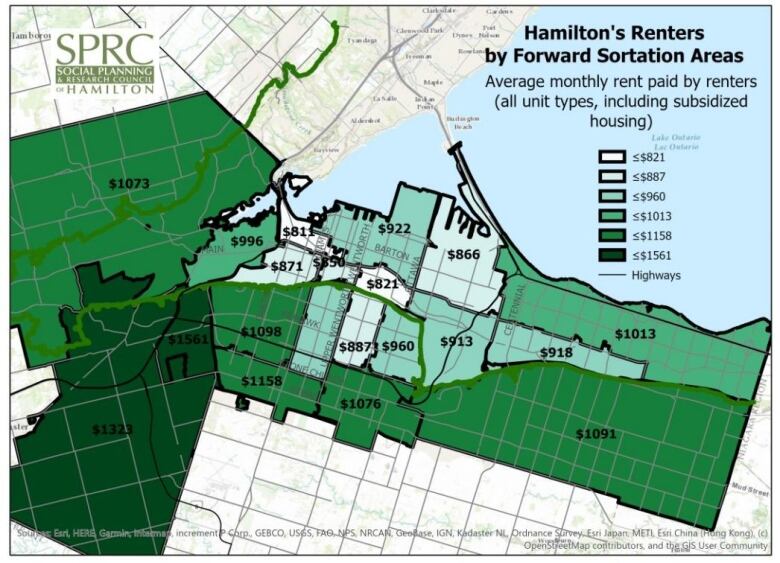45 per cent of Hamilton renters living in unaffordable housing, new report says
Average rent in the downtown core, mountain has risen 40 per cent in 8 years

Reports released by the Social Planning and Research Council of Hamilton show that 45 per cent of renters are living in unaffordable housing and using a disproportionate amount of their income just for shelter.
The Social Planning and Research Council of Hamilton (SPRC) is publishing documents overthe next few weeks on the rental housing crisis in Hamilton, whereprices keep rising and residentscan't keep up.
The non-profit hasreleased its first fourbulletinsas part of a 15-partseries. The reportsshow quickly rising rental prices that demand a greater percentage of people's incomes and howevictions for reasons other than non-payment further the problem.
Sara Mayo, social planner of geographic information service with SPRC, explainedthat the group was influenced by industries lauding price increases in the housing market as a good thing,and wanted to shed light on the downsides.
"The housing market is causing a lot of stress and negative situations for lots of people in Hamilton," she said. "Not enough attention is paid to the rental market...there's not enough discussion ofthe negative impacts."
Prices not in line with inflation
Part of the problem, she said,is that rental prices are surpassing inflation rates. While rental priceswere increasing at a rate close to inflation from 2001 to 2015,the SPRC says the costs are now growingexponentially.
Based on data from the Canada Mortgage and Housing Corporation (CMHC), the non-profit says that from 2015 to 2018, inflation rose by six per cent, whilerental pricesfor private units increased by 21 per cent.
People feel trapped...if they leave their apartment, they leave affordable housing.- Sara Mayo, social planner, SPRC Hamilton
If prices were to increase by inflation, the SPRC says average market rent for a private rental unit would be $884 instead, it's $1,009.
And if this cost seems low compared to what you see advertised online, the group says there's a reason for that.
The average priceprovided by theCMHC, it says,takes into account rent being asked by landlords and rents beingpaid by current renters the latter group brings thisaverage down.Informationon rental websites, which only includespricesof when the units turn over, are higher because it shows the prices of places available.
Evictions for reasons other than non-payment rise
Hamilton is among the cities with the fastest growing prices when compared to neighbouring communities. The report says that between 2017 and 2018, Hamilton's average rents spiked 6.9 per cent a rate higher than the provincial average.
The non-profit says that the numbers are skyrocketing asrents increase forexisting units and higher quality unitsthat cost more are built around the city.
According to the SPRC, eviction notices for reasons other than non-payment of rent,such asrenovations that create these higher quality units, have more than doubled.
There were60 incidents recorded by the Landlord Tenant Board in 2010 and 150 recorded in 2018.The non-profit said that the board does not track "informal evictions," such as when amenitieslike laundry roomsclose in a building, influencing its residents to live elsewhere.

The number of these eviction notices, called L2 notices,are highest in some of the most affordable rental neighbourhoods. The highest is in the Corktown and Stinson areas. Mayo said that when people move out, it allows these affordable prices to continually increase.
Renters living in unaffordablehousing
When it comes to rising costs, one-bedroom rentals inthe downtown core and mountain have seen the greatest increases in average rent, with awhopping 40 per cent risefrom 2010 to 2018. The downtown core is also home to the mostrental units, while the mountaincomes second.
The mountain, however,hasthe largest number of family size units.
Areas with the greatest increase in average rent for two-bedroom rentals are the mountain and Hamilton's east and west ends.

When wages don't rise as quickly as rental prices, families need to pay a bigger part of their income for shelter. The SPRC's report says that 45.4 per cent of renter households are living in unaffordable housing, meaning they spend around 30 per cent of their income on housing costs.
Some are spending even more 20per cent of renters are spending 50 per cent or more of their income on housing.
Mayo said theunaffordability rate shows the lack of affordable housing in Hamilton despite beingtalked about as less expensivethan other places. When the housing market is discussed, she said, the problem is it often comes from a Toronto lens. And when the rates to live in Toronto are so high, it can paint a distorted picture of the rates in Hamilton.
Thepercentage of people using a high amount of their income is in line withthe provincial average 45 per cent of people use 30 per cent of their income on rent, where 20.9 per cent use half of their income on average.
Mayo saidthis highlights how people are struggling.
"Because Hamilton has 'low rent,' it's seen as 'oh, it's not as much of an issue,'" she said. "Rents are cheaper here, but incomes are lower in Hamilton, so we still have affordability challenges despite lower rents."

She added that people might feel pressured to stay in an area despite difficultiesbecause of the intimidating and unaffordable prices out there.
"People really feel trapped," she said. "If they need to move because their job is in a different part of the city, well they can't move because if they leave their apartment, they'll leave affordable rent."
The non-profitreferences a report from the think-tank Canadian Centre for Policy Alternatives, which shows that someone earning minimum wage would have to work 54 hours a week to afford a one-bedroom apartment in Hamilton.
Future bulletins from the non-profit will focus on impacts to renters and the difficulties they face, as well as the buildings they live in.












_(720p).jpg)


 OFFICIAL HD MUSIC VIDEO.jpg)
.jpg)



























































































